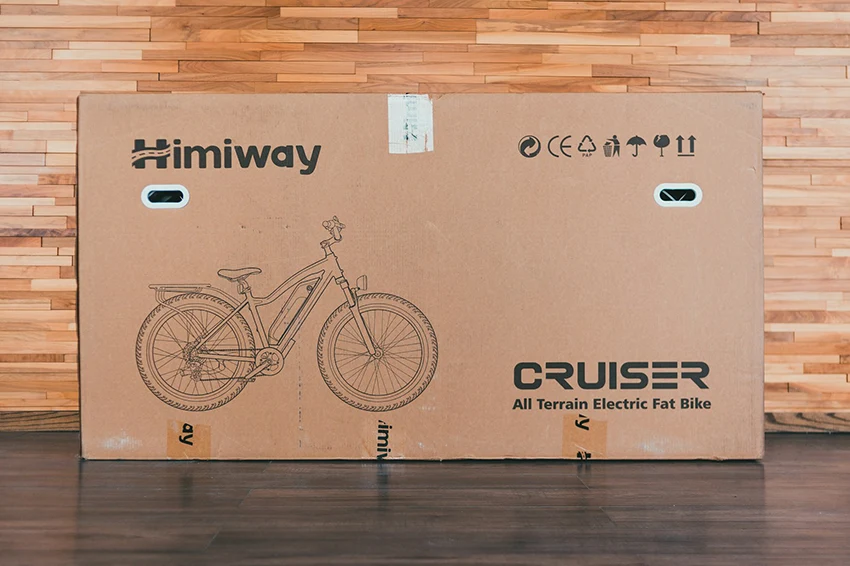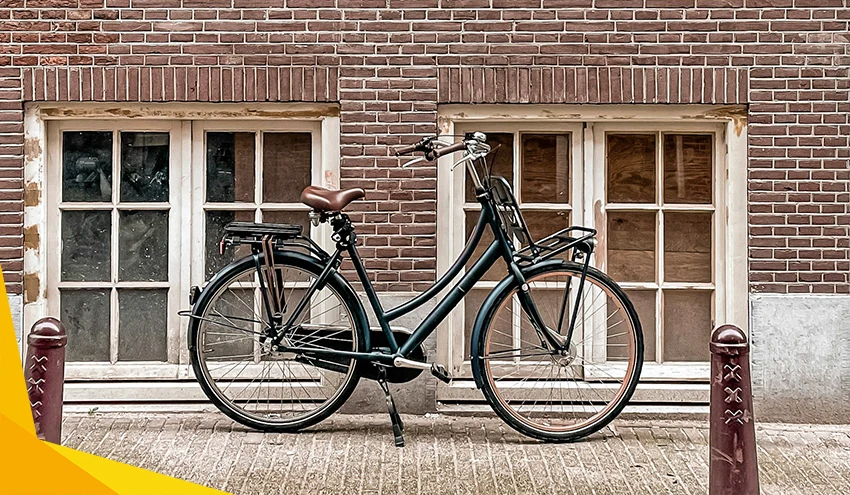Are you thinking about transporting your bicycle by air, land, or sea? If that’s the case, understanding bike box dimensions is crucial to ship your bike seamlessly and avoid costly fees.
Whether you’re an avid cyclist planning a bike tour, a bike seller shipping to a customer, or simply storing your bike over the winter, knowing the exact dimensions of a bike box ensures your bicycle’s safety and minimizes hassle.
In this comprehensive guide, we’ll delve deep into the most important aspects of bike box dimensions, covering everything from standard sizes for different bike types, weights, airline regulations, packing techniques, and custom box solutions.
Contents
- Standard Bike Box Dimensions
- Determining What Bike Box Dimension You Need
- Types of Bike Boxes to Consider
- Average Bike Box Cost
- Average Bike Box Weight (+Max Allowed Weight)
- Preparing Your Bike for the Box
- Packing and Shipping Your Bike Properly
- Airline Regulations and Standards for Bike Box Dimensions
- When to Consider Custom-Made Bike Boxes?
- Conclusion
Standard Bike Box Dimensions
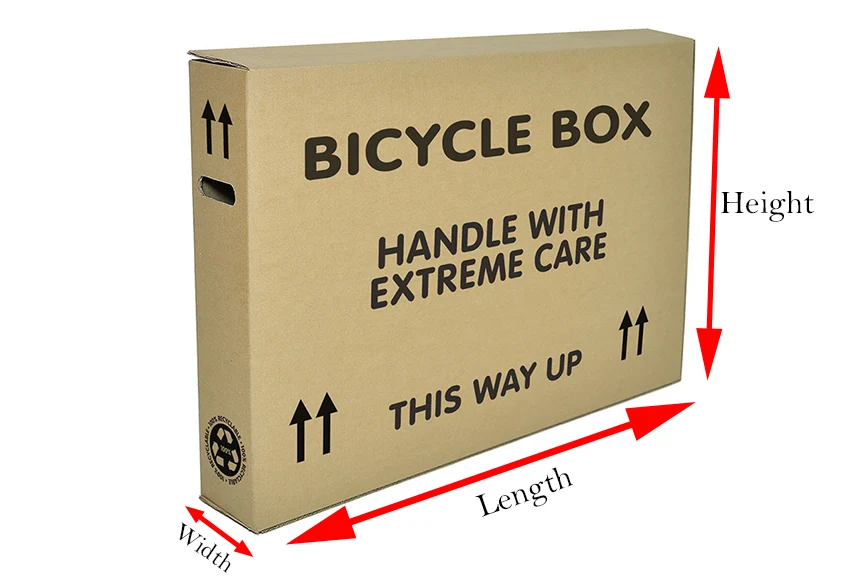
Let’s first address the main question you probably have—what is the size of a bike box?
The size of a standard bike box is usually 43 x 11 x 32 inches or 110 x 28 x 82 cm. This is the most common size because it fits most types of bikes and falls within the 115-inch international shipping size limit.
However, this is not the only type of bike box you can get. There are other sizes available, depending on the type of bike you’re shipping and other gear you might want to fit inside it, such as bike accessories and other cycling equipment.
Other common sizes you can find include:
- 47 x 11 x 32 inches (120 x 28 x 82 cm)
- 51 x 11 x 32 inches (130 x 28 x 82 cm)
- 53 x 9 x 29 inches (134 x 73 x 22 cm)
- 54 x 8 x 28 inches (137 x 71 x 20 cm) (FedEx Size: Fits most bikes)
- 55 x 32 x 11 inches (140 x 28 x 82 cm)
- 56 x 32 x 21 inches (142 x 53 x 81 cm)
Despite these common sizes, it’s important to note that there are no agreed-upon bike box dimensions that all manufacturers or shipping companies are sticking to.
Instead, the dimensions typically vary depending on the type of bike that it’s designed for, which is how you should approach your situation as well.
Determining What Bike Box Dimension You Need
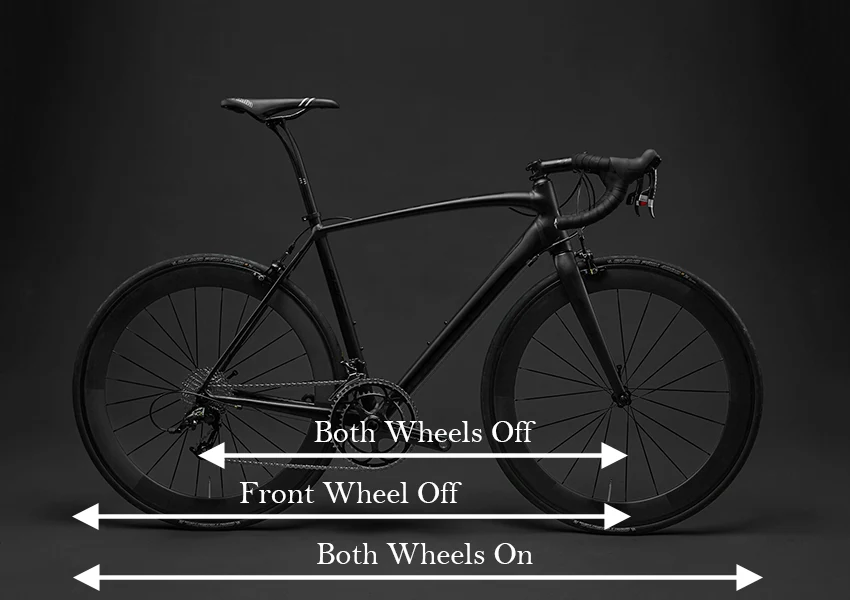
The best way to determine what bike box size you need is to measure your bike.
We recommend measuring your bike in three different ways to have more packing options to consider.
- First, measure your bike from end to end including both wheels.
- Next, measure your bike from the end of the rear wheel to the front fork (as if the front wheel is off).
- Finally, measure the bike from the front fork to the rear chainstays as if both wheels are off (frame length only).
By knowing these three dimensions, you can decide how you want to pack and ship your bike—with both wheels on, both wheels off, or the front wheel off only—and get an appropriately sized box.
For practical reasons, we recommend shipping your bike by taking the front wheel off only, as this makes it easier to reassemble the bike at the final destination.
In addition to that, taking the rear wheel off will expose your rear derailleur to damage, which means you need to spend extra time to protect it properly before shipping.
Types of Bike Boxes to Consider
Depending on the type of bike you’re planning to ship or transport, you might want to consider different types of bike boxes—cardboard, hardcase, and soft bike bags.
Each type has specific advantages and disadvantages, such as affordability, protection, and practicality, so the right type will depend on your needs.
Let’s help you decide!
Cardboard Bike Box
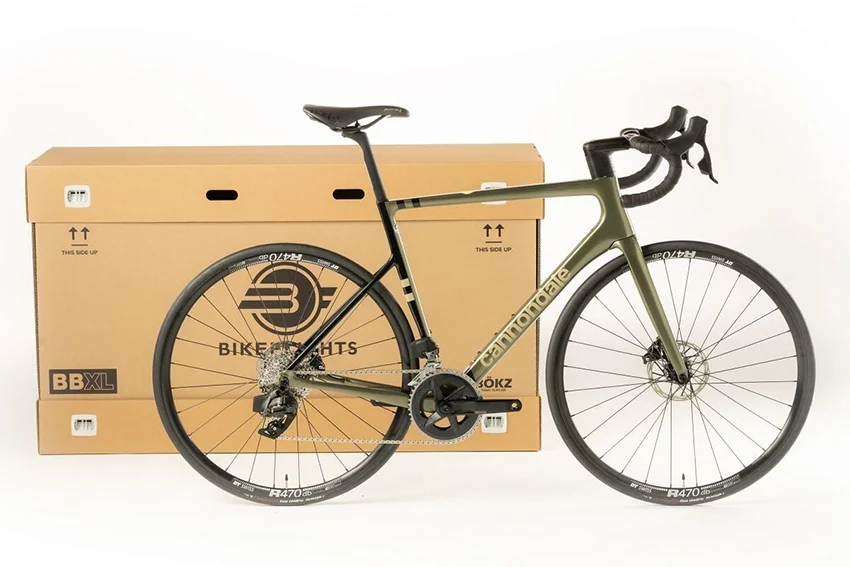
Cardboard boxes are the simplest and cheapest solutions that will get the job done for most people, in most situations.
A cardboard box is lightweight, typically weighs around 4.5 lb (2 kg), and can be sourced for free (or cheap) from most local bike shops.
Cardboard boxes can also be discarded once you reach your destination, but they don’t provide much protection on their own.
Therefore, you need to spend extra time securing your bike properly with foam, bubble wrap, and additional cardboard sheets.
Hardcase Bike Box
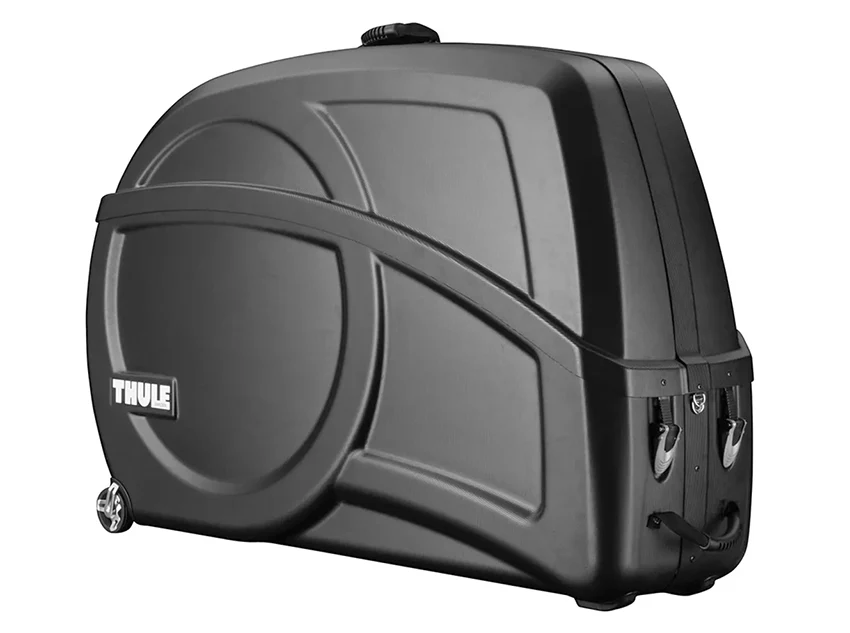
Hardcase bike boxes offer a lot more protection compared to cardboard boxes, but they are also much more expensive.
Due to the protection they offer, they are also much heavier at around 22+ lb on average (10+ kg).
Read more: Best Bike Travel Cases
Another disadvantage is that once you get one, you can’t simply dispose of it, so they are not great for bicycle touring (with a few exceptions).
However, a good thing about hardcase boxes is that they typically have slots for different bike parts (wheels, frame, handlebars, etc.), which makes packing much faster.
Soft Bike Bag
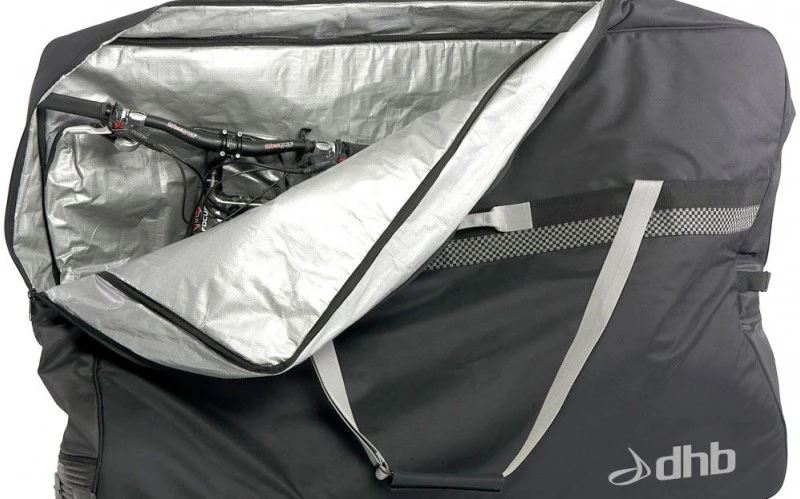
Finally, soft bike bags are much lighter and cheaper than the other two types of boxes but offer the least amount of protection for your bike.
These bags provide plenty of room to fit your bike, accessories, and even some gear, and they fold neatly when not in use.
We recommend using soft bike bags when traveling by car, but they are not ideal for shipping your bike or transporting it on an airplane.
Average Bike Box Cost

If you’re lucky, you can get a cardboard bike box for free from your local bike shop. Just ask politely and most bike shop owners will be happy to give you one (if not for free then for a symbolic price).
But if your LBS does not have any spare bike boxes at the moment or you don’t have any LBSs nearby, you can also buy one online. The price depends on the size, cardboard thickness, and any additional protective features.
For example, purchasing a bike box from FedEx costs between $15 and $40, depending on where you buy it.
A few other (more costly) online options you can consider include:
- Bikeflights.com: $120 – $150
- Sendbike.com: £25 – £40 (UK)
- Shipbikes.com: $20 – $400
- Amazon.com: A range of options
As you can see, new cardboard bike boxes can be quite expensive when bought online, so your best bet is to try to get a used one for free (or much cheaper) from a local bike shop.
Average Bike Box Weight (+Max Allowed Weight)
The weight of a cardboard bike box typically ranges between 4.4 lb and 6.6 lb (2-3 kg) depending on the type of cardboard used and the box dimensions.
Some heavy-duty bike boxes, such as the ones sold by Bikeflights, weigh as much as 22 lb (10 kg), which is about the same as a hardcase box.
Most airlines allow a maximum weight of 70 lb (32 kg) when shipping a bike or other types of sports equipment, so it’s a good idea to get a bike box that’s not too heavy to avoid paying baggage excess weight fees.
Preparing Your Bike for the Box
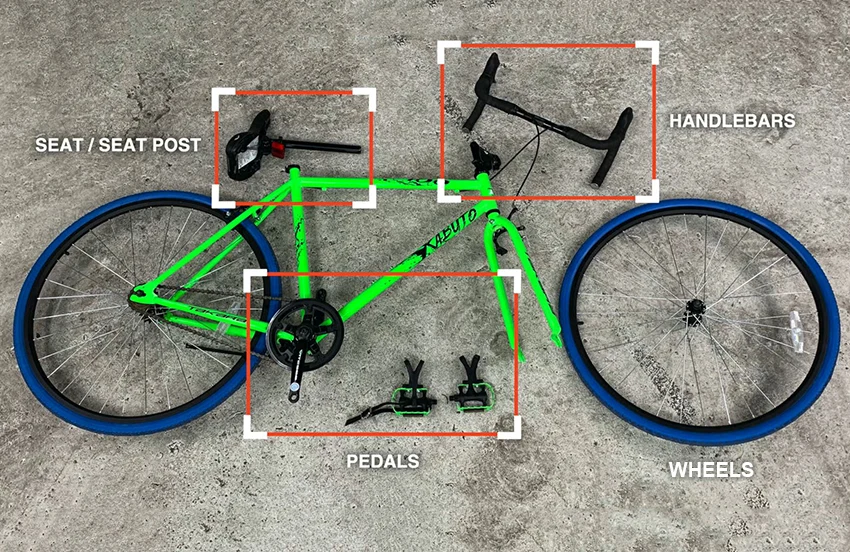
Preparing your bike for shipping or transporting inside a box is crucial if you want to ensure the job is done seamlessly and your bike doesn’t suffer any damage.
Here are the exact steps you need to follow to achieve this.
Step 1: Remove the handlebars
The first step is to remove the handlebars and tape them sideways, parallel to the frame.
To achieve this, you need to undo the four screws that attach the handlebar to the stem and then screw them back into place so they don’t get lost.
Step 2: Remove the seat post
The next step is to remove the seat post together with the saddle.
To do this, you need to undo the clamp where the seat post enters the frame’s seat tube and pull the seat post out.
If you have a dropper post, you’ll have to disconnect the cable as well. But depending on your bike box dimensions, you may get away by just taking off the saddle.
Step 3: Remove the pedals
Now it’s time to remove the pedals by using an Allen wrench or pedal wrench and turning it towards the back of the bike on each side.
We recommend tying the pedals together with a zip tie or tape, so you don’t forget to pack one of them by mistake.
Step 4: Remove the wheel(s)
Depending on the length of your bike box, you may need to remove one or both of your wheels. If you have a large enough box, you may not need to remove them at all.
In most cases, removing the wheels is easy, as all you need to do on modern bikes is to undo the quick-release lever and pull the lever out or unscrew the thru-axle.
If your bike uses rim brakes, you’ll need to release some cable tension in the brakes to make room for the wheel to slide between the brake pads.
If your bike uses disc brakes, it’s a good idea to place some kind of a divider between the calipers—without this, if you accidentally pull the brake levers with the wheels off, the calipers might come in all the way.
Step 5: Remove any accessories
Finally, if your bike comes with accessories such as racks, fenders, a kickstand, aero bars, and similar, you may need to remove them before packing the bike inside the box.
This depends on the dimensions of your box; in some cases, you won’t need to remove all of the accessories.
Once you remove any accessory, we recommend putting all the screws into dedicated plastic bags and labeling them properly, so it’s easy to reassemble them later on.
Packing and Shipping Your Bike Properly
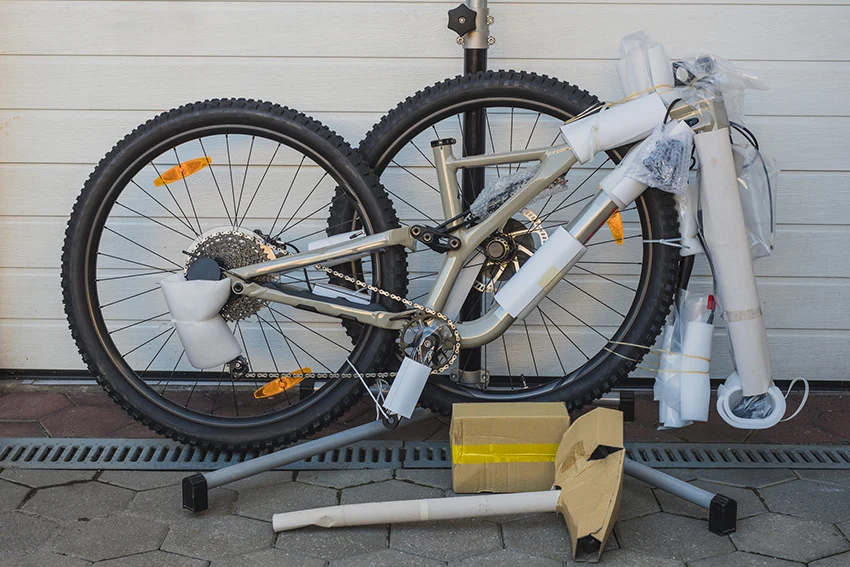
Packing your bike is pretty straightforward once you’ve disassembled it properly.
But first, to pack your bike securely, you need to get a few additional supplies to protect the frame and components and secure the bike. These are:
- Plumbing insulation (foam)
- Bubble wrap
- Spare cardboard sheets
- Ductape
- Zip ties
- Plastic bags
Now that you have all the supplies that you need, you can follow the steps below to pack your bike properly:
- The first thing to do before packing your bike is to protect the frame’s tubing with plumbing insulation. Cut it to size and wrap it around all the tubes that might get damaged (top tube, down tube, seat tube, fork, etc).
- Next, turn the handlebars sideways and tape them securely to the (now insulated) top tube. If necessary, add some bubble wrap to it for additional protection.
- Once you’ve removed the pedals, tape them or zip-tie them together, wrap them in a bubble sheet, and put them inside the bike later on.
- After removing the seat post and saddle, you should wrap the seat post in some bubble wrap as well, as it can scratch other parts of your bike.
- The next step is to remove the wheels (one or both) and wrap the exposed ends of the bike’s frame in some bubble wrap to prevent scratches. Wrap the wheel axles as well, as they can scratch other parts of your bike.
- Now, place the bike inside the box, followed by the pedals, seat post, and wheels, as well as any other parts or gear you’ve removed. It should all fit nicely and securely. Fit additional sheets of cardboard between different parts of your bike to make sure they don’t scratch each other.
- Finally, tape up the box securely, and you should be ready to go!
Airline Regulations and Standards for Bike Box Dimensions

If you’re planning on transporting your bike via an airline company, you should know the weight and size limits, as well as a few other guidelines, to avoid costly fees.
In general, most airlines have agreed upon a maximum linear size (length + width + height) of around 115 inches (~300 cm) and a maximum weight of around 70 lb (32 kg).
The standard bike box size easily fits this requirement (43 + 32 + 11 = 86 inches), as well as the standard FedEx bike box size (54 + 28 + 8 = 90 inches).
But, keep in mind that the exact size limit varies from one company to another, so it’s a good idea to double-check it on the company’s website before traveling.
In addition to the limit on the bike box dimensions, there are a few other guidelines that you need to follow to be eligible to ship your bike, including:
- Your bicycle must be contained in a protective bike box or bike bag.
- The handlebar must be turned and secured parallel to the bike’s frame.
- The pedals must be removed from the bike.
- The tires must be fully deflated before shipping in a cardboard box.
- Electric bikes cannot be transported on airplanes.
When to Consider Custom-Made Bike Boxes?
In case your bike does not fit in a standard bike box or you’re unable to obtain one (your LBS doesn’t have one and you don’t want to pay for one), you can make a custom bike box.
To do this, you can find a big cardboard box (or several boxes that you can tape together) and cut it to size. Luckily, cardboard boxes can be easily cut to size and shaped to fit different needs, including shipping a bike.
If you have old cardboard boxes from your fridge or other large home appliances stashed somewhere in your house, you can easily repurpose them for shipping your bike.
However, keep in mind that you need to be at least minimally crafty to do this, or watch a few YouTube videos to get an idea of what approach to take.
Conclusion
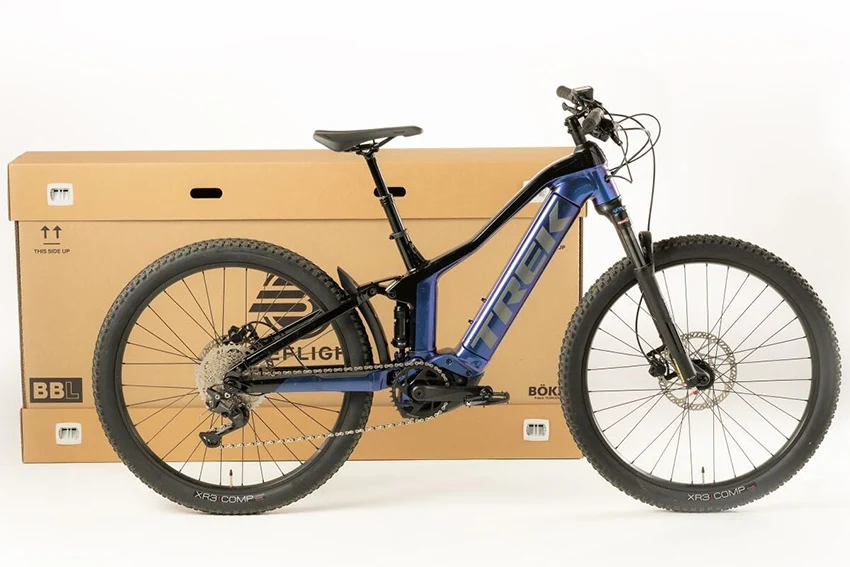
In conclusion, the task of transporting your bicycle, be it by air, land, or sea, begins with a solid understanding of bike box dimensions.
As we’ve learned in this guide, standard bike boxes generally come in a few different sizes, but exceptions exist to accommodate different types of bicycles and additional gear.
Choosing the right box—cardboard, hardcase, or soft bike bag—depends on your specific needs, relative to factors like cost, protection, and convenience.
Remember to measure your bike accurately and consider airline regulations if flying to avoid costly fees.
Once you have the right box, the key lies in proper preparation and correct packing, ensuring your bicycle arrives safely and ready for your next adventure or storage period.
Related Posts:
Best Touring Bikes for Multi-Day Trips
Best Bikepacking Bags to Consider
Touring Bike vs Road Bike – The Main Differences

